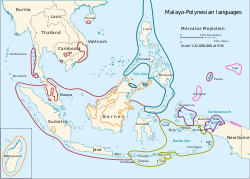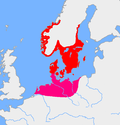Nasal ([naˈsal]) is an Austronesian language of southwestern Sumatra. Anderbeck & Aprilani (2013) consider Nasal to be an isolate within the Malayo-Polynesian...
3 KB (262 words) - 18:01, 7 February 2025
languages. There are also other kinds of nasal consonants in some languages. Nearly all nasal consonants are nasal occlusives, in which air escapes through...
21 KB (2,456 words) - 13:56, 29 May 2025
velar nasal, also known as eng, engma, or agma (from Greek ἆγμα âgma 'fragment'), is a type of consonantal sound used in some spoken languages. It is...
33 KB (1,331 words) - 15:51, 30 May 2025
of the word hand is affected by the following nasal consonant. In most languages, vowels adjacent to nasal consonants are produced partially or fully with...
12 KB (1,332 words) - 05:34, 4 May 2025
Look up Nasal, Nasals, nasal, nasals, or naso- in Wiktionary, the free dictionary. Nasal /ˈneɪzəl/ is an adjective referring to the nose, part of human...
2 KB (273 words) - 03:53, 13 March 2025
The voiced palatal nasal is a type of consonant used in some spoken languages. The symbol in the International Phonetic Alphabet that represents this sound...
33 KB (1,850 words) - 12:09, 4 June 2025
The voiced alveolar nasal is a type of consonantal sound used in numerous spoken languages. The symbol in the International Phonetic Alphabet that represents...
36 KB (1,661 words) - 17:50, 1 June 2025
(approximately 450 languages) The position of the recently rediscovered Nasal language (spoken on Sumatra) is unclear; it shares features of lexicon and phonology...
20 KB (1,541 words) - 16:55, 19 June 2025
The voiced uvular nasal is a type of consonantal sound, used in some spoken languages. The symbol in the International Phonetic Alphabet that represents...
12 KB (923 words) - 18:52, 17 June 2025
The voiceless bilabial nasal (stop) is a type of consonantal sound, used in some spoken languages. The symbol in the International Phonetic Alphabet that...
11 KB (769 words) - 01:07, 5 May 2025
Aspirated nasal clicks, often described as voiceless nasal with delayed aspiration, are widespread in southern Africa, being found in all languages of the...
6 KB (741 words) - 04:10, 20 April 2025
Nasalization (redirect from Nasal accent)
ã̀ ã̂ ã̌]. Many languages have nasal vowels to different degrees, but only a minority of world languages around the world have nasal vowels as contrasting...
11 KB (1,269 words) - 07:38, 24 May 2025
N (section Other languages)
Etruscan, Latin, and modern languages. In English, ⟨n⟩ usually represents a voiced alveolar nasal /n/, but can represent other nasal consonants due to assimilation...
15 KB (1,202 words) - 11:25, 18 May 2025
either oral or nasal, while voiceless consonants are unaffected, as in oral /ᵐbotɨ/ vs nasal /mõtɨ̃/. Guarani is a highly agglutinative language, often classified...
44 KB (3,749 words) - 21:48, 9 June 2025
ingressive pulmonic airflow." Taa is the only language known to contrast voiceless nasal and voiceless nasal aspirated (i.e. delayed aspirated) clicks (Miller...
34 KB (3,150 words) - 11:50, 22 June 2025
The voiced labial–velar nasal is a type of consonantal sound, used in some spoken languages. The symbol in the International Phonetic Alphabet that represents...
6 KB (522 words) - 16:48, 9 September 2024
The voiced retroflex nasal is a type of consonantal sound, used in some spoken languages. The symbol in the International Phonetic Alphabet that represents...
8 KB (644 words) - 07:15, 21 June 2025
phonemic) nasal/non-nasal contrasts occurred in the West Germanic languages down through Proto-Anglo-Frisian of AD 400 or so. Proto-Germanic medial nasal vowels...
134 KB (12,264 words) - 02:05, 23 June 2025
three further diacritics are used on vowels and syllabic nasal consonants to indicate the language's tones: an acute accent ⟨´⟩ for the high tone, a grave...
50 KB (5,005 words) - 23:52, 15 June 2025
widely-spoken languages. Vowel systems per Masica (1991:108–113) are listed below. Many languages also have phonemic nasal vowels. Sylheti language is one of...
78 KB (5,877 words) - 11:06, 23 June 2025
generally counted as a distinct language.[citation needed] There are 5 vowel qualities, found as oral /i e a o u/ and nasal /ĩ ã ũ/. /u/ is strongly rounded...
24 KB (2,248 words) - 15:39, 28 May 2025
The voiceless nasal glottal approximant is a type of consonantal sound, a nasal approximant, used in some oral languages. The symbol in the International...
4 KB (310 words) - 12:40, 21 March 2025
The voiced bilabial nasal is a type of consonantal sound which has been observed to occur in about 96% of spoken languages. The symbol in the International...
28 KB (1,056 words) - 01:11, 17 June 2025
consonants is that only nasal stops may be syllabic, a common pattern cross-linguistically. Ewe is a tonal language. In a tonal language, pitch differences...
22 KB (2,032 words) - 04:20, 20 June 2025
Ñ (category CS1 Spanish-language sources (es))
the identity of the Spanish language. In Spanish it represents a palatal nasal. This is also the case of Philippine languages, Aymara, Quechua, Mapudungún...
23 KB (2,451 words) - 11:09, 19 May 2025
long or short, oral or nasal: /iː eː ɛː aː ɔː oː uː/ and /ĩ ẽ ɛ̃ ã ɔ̃ õ ũ/. (It may be that all nasal vowels are long.) Nasal vowels nasalize some following...
6 KB (477 words) - 00:56, 8 February 2025
The voiceless alveolar nasal is a type of consonant in some languages. The symbols in the International Phonetic Alphabet that represent the sound are...
9 KB (662 words) - 01:55, 17 June 2025
The voiceless uvular nasal is an extremely rare type of consonantal sound, used in very few spoken languages. The symbol in the International Phonetic...
3 KB (345 words) - 07:20, 21 January 2025
The nasal palatal approximant is a type of consonantal sound used in some oral languages. The symbol in the International Phonetic Alphabet that represents...
8 KB (610 words) - 02:09, 5 May 2025
The lateral nasal click is a click consonant found primarily among the languages of southern Africa. The symbol in the International Phonetic Alphabet...
5 KB (390 words) - 18:42, 26 May 2025
















